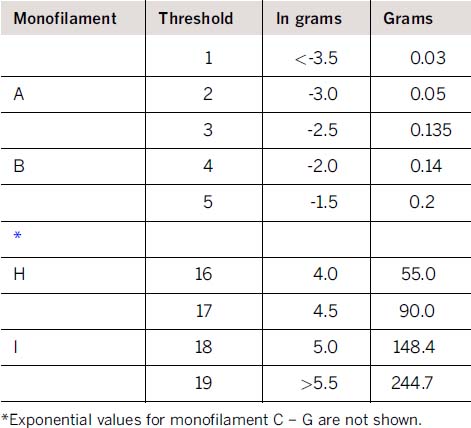Figure 76-1 Dyck Monofilaments. Modified Semmes Weinstein Monofilaments described in text. Note that monofilaments A, B, and C are so fine that they are almost invisible in this photograph.
Standard anatomic sites
The standard sites for human testing are (1) dorsal distal phalanges of the five toes, 3 to 5 mm proximal to the base of the toenails; (2) plantar surface of the foot, 2.5 to 3 cm distal to the convexity of the metatarsal heads; (3) midlateral leg; (4) midanterior thigh; (5) dorsal distal phalanges of hand digits (and as for site 1); (6) midvolar forearm; (7) lateral shoulder; and (8) maxillary region.
To be a standard test, it is necessary to follow appropriate and consistent rules of testing. The tip of the monofilament is positioned 1 to 2 mm above the surface of the skin, gently lowered to make contact with the skin, bent to 5/6th of the extended length of the monofilament, and then released slowly. The observer takes 1.5 to 2 seconds to smoothly make and then break contact with the skin, avoiding impact or excessive movement of the filament over the surface of the skin. The observer attempts to use the same arm movement and time to perform the real and the null stimulus, but for the latter, the monofilament makes contact only with the test platform but not with the skin. Intervals 1 and 2 are identified verbally.
Algorithms of testing
For a given test site, the observer may begin testing using a method of limits. In this approach, the observer employs increasingly strong stimuli, with or without interspersed null stimuli. With the subjects eyes closed, the observer asks the patient to say “yes” every time the patient is touched. The objective is to obtain an approximate level of threshold, that is, at which level the stimulus is felt 50% of the time. The observer may begin with monofilament B giving a stimulus to each of the five toes. The intervals between stimuli are varied so that application of stimuli cannot be predicted. If most stimuli are felt and null stimuli are not felt, the observer may begin testing with the 2-alternative forced choice algorithm (described later) at this stimulus level. If monofilament B is not felt or felt only once or twice (in five trials), the observer may choose to test next with monofilament D. The observer uses this method of limits to introduce the patient to touch-pressure testing and to get an approximate idea of threshold at the site tested.
The 2-alternative forced choice algorithm is used to ascertain threshold with greater certainty. Ideally, testing begins at a stimulus level near but below or above threshold. In this algorithm, 10 pairs of stimulus events corresponding to the speaker’s words “one” then “two” and having a stimulus and a null stimulus assigned to periods 1 and 2 using random assignment. By restricted randomization, in 5 of the 10 pairs of stimulus events, the stimulus is given in period 1. The patient must choose whether the stimulus occurred in period 1 or 2. A correct response in 7 or 8 of 10 pairs tested, results in threshold being declared for that stimulus level. If less than 7 of 10 pairs are correctly identified, the threshold is at stronger stimulus levels and so testing must continue with stronger stimuli. If more than 8 of 10 pairs were correctly identified, threshold must be at a weaker stimulus level. The same rules apply for each level tested or until the site is declared supersensitive (level 1) or insensitive (level 19).
Predetermined steps of testing and data entry sheets or a PC program may be used to give the order of testing, allow data entry, calculate thresholds, and provide a permanent record. The use of the PC program (which can be obtained from WR Medical Electronics, Stillwater, MN) has the considerable advantage of providing instruction, facilitating accurate entry of stimuli given and results obtained, estimating threshold, and providing a final typed record.
Stay updated, free articles. Join our Telegram channel

Full access? Get Clinical Tree









